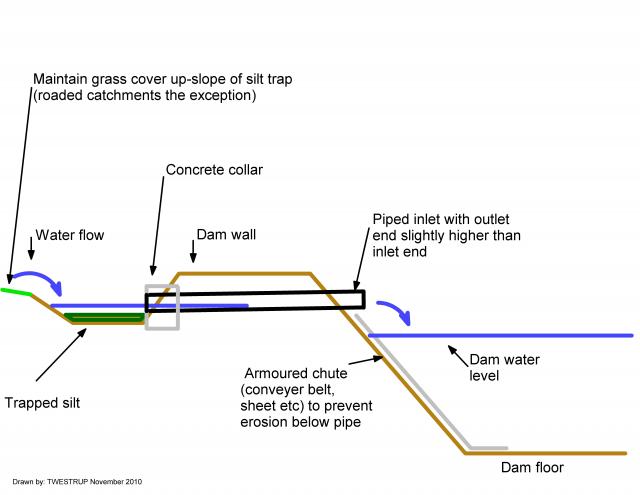Silt washed into farm dams reduces dam storage volume, increases the chance of algal blooms and increases the proportion of water lost to evaporation.
Desilting affected dams will reduce the likelihood of aquatic weeds and algal blooms, increase storage volume and prolong the life of the dam structure.
This information applies to farm dams (excavated earth tanks) with a natural catchment or catchment banks. Farm dams with a well constructed roaded catchment rarely accumulate much debris or silt.
Why de-silt a dry dam?
Do you have a silt trap? If you do, then you can easily clean silt from the trap; if you don't, then the dam will gradually accumulate organic material and silt from the catchment. See guidance below on how to create silt trap.
Desilting will increase the storage volume of a dam and remove the accumulated organic material and nutrients that provides growing conditions for aquatic weeds and algae.
A dry dam provides an opportunity for machinery access that would not normally exist. While machinery is on-site, the overflow, dam seal or inlet can also be maintained.
Cleaning out dams before any summer storms is a wise move because the opportunity may not come again for some time.
How to remove silt from your dam
You can use a bulldozer, scraper or excavator on a dry dam base to remove silt, taking care to not break the dam seal.
Removing silt from a wet dam is complicated and can be dangerous and expensive. Dredging scoops or dredging pumps can be hard to find for farm use and we recommend that you contact specialist operators to do this job.
There is an increased safety risk from using machinery in this situation and we recommend that relevant safety procedures are always used.
How to dispose of the silt
Avoid environmental damage when desilting dams. Silt, by its nature, is highly mobile in the landscape.
Do not place recovered silt in or near drainage lines: there is an increased risk of the nutrient-rich silt washing back into the dam, or into the next dam downstream, or washing into rivers and wetlands to cause eutrophication.
Spread silt with a particularly high nutrient content onto poor sandy soils. Using an elevated scraper is an efficient way of doing this. The cost of this operation could be offset by the 'claying' effect which reduces water repellence, increases water and nutrient holding capacity of the soil and reduces susceptibility to wind erosion. These factors together may give reasonable crop and pasture yield increases.
READ MORE- South African Dams and water situation.
Avoid spreading silt with a high salt content. Silt from a dam with high salinity water will have high levels of salt. Test the salt level of the silt and receiving paddock, and seek advice if the levels are high enough to reduce crop or pasture growth.
Prevent silting of your dam – use a silt trap
Silt traps are an effective way of reducing silt moving into dams. Good groundcover in the upstream catchment combined with management of surface water will significantly reduce siltation in the trap and the dam. We recommend using piped silt traps rather than overflow silt traps (Figure 1).
Dams that dry out may need improved water harvesting, and we recommend using roaded catchments. Poorly designed and constructed roaded catchments may lead to a lot of silt movement; a silt trap may provide a short-term solution, but the roaded catchment should be reconstructed to industry standards.
The silt trap in Figure 1 can be fitted to existing dams, or incorporated into the design of new farm dams. We recommend that the silt trap size is 500 to 1000 m3, with the pipe from the trap to the dam delivering water just above the maximum water height in the dam (set by the spillway height). In the silt trap, the pipe needs to be above the base of the trap, so that silt and rubbish does not flow straight into the pipe. A coarse mesh on the pipe inlet will help to restrict entry of rubbish.

Figure 1 A well designed silt trap will help reduce silt load in a dam













